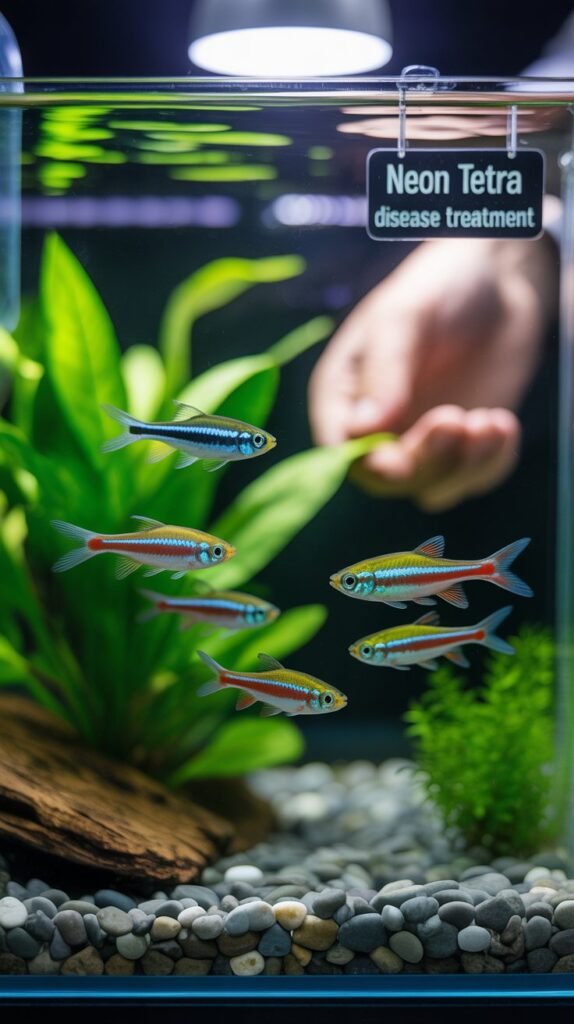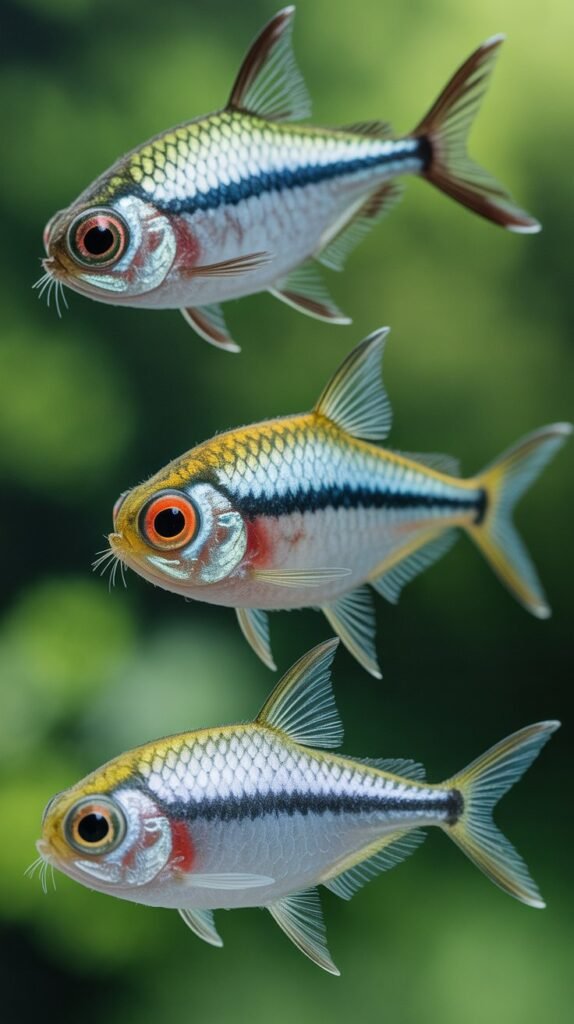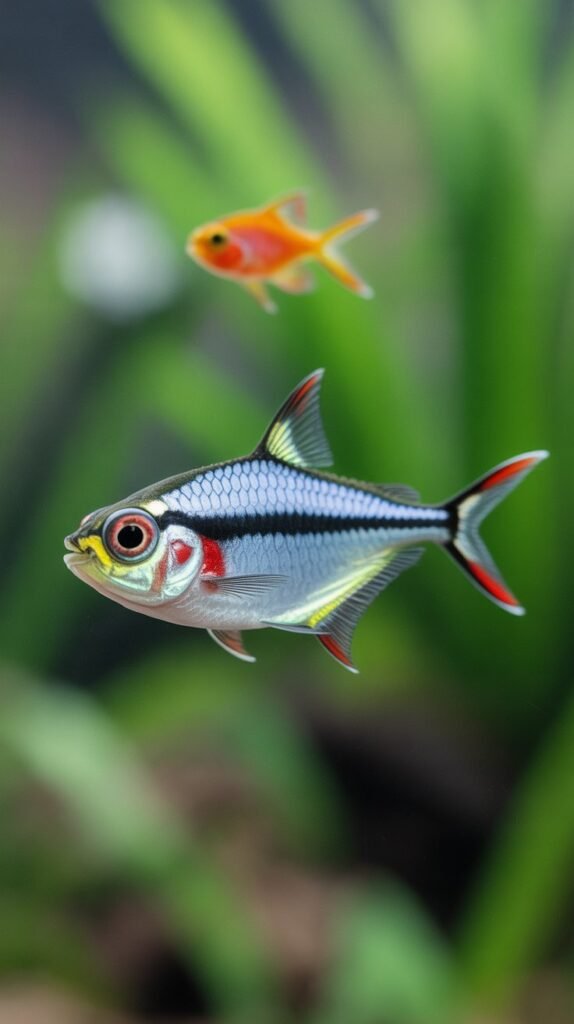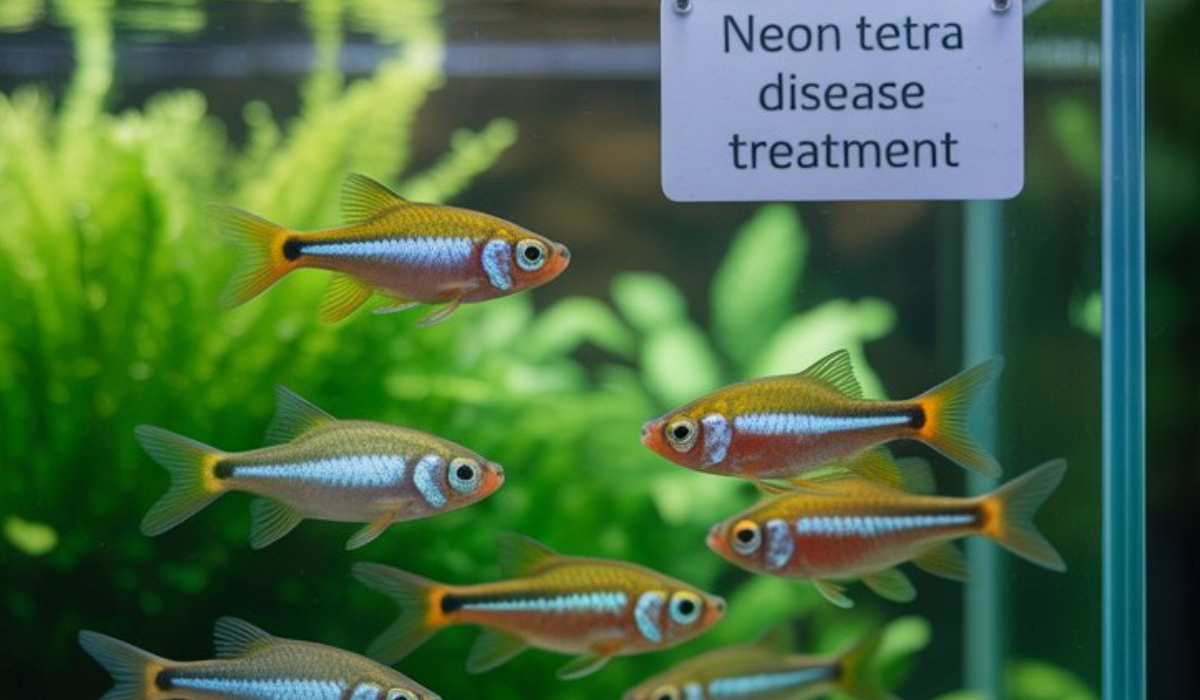Neon Tetras are some of the most beloved freshwater aquarium fish, admired for their striking blue and red stripes and peaceful temperament. However, one of the most devastating challenges that aquarists face is Neon Tetra Disease (NTD) — a parasitic infection that can quickly spread through your aquarium and cause high mortality rates.
If you’re searching for Neon Tetra Disease treatment, you’re not alone. Many fishkeepers encounter this problem at some point and struggle to manage it effectively. Although there is no known cure for the disease, there are ways to control, prevent, and limit its spread, ensuring that your remaining fish remain healthy.
In this comprehensive guide, you’ll learn everything about Neon Tetra Disease treatment, including causes, symptoms, management steps, alternative remedies, and prevention strategies to safeguard your aquarium in the future.
What Is Neon Tetra Disease?
Neon Tetra Disease (NTD) is caused by a microsporidian parasite known as Pleistophora hyphessobryconis. This parasite invades the muscle tissue of infected fish, multiplying rapidly and forming cysts that destroy muscle fibers and internal organs.

Although it was first identified in Neon Tetras, this disease can also affect other species such as:
- Cardinal Tetras
- Guppies
- Rasboras
- Angelfish
- Zebra Danios
- Glowlight Tetras
The infection is highly contagious and can spread through contaminated food, water, or by healthy fish consuming the remains of infected tankmates.
Causes of Neon Tetra Disease
Understanding how the disease spreads is essential for successful treatment and prevention. The parasite enters a fish’s body primarily through ingestion of infected tissue, but several factors contribute to outbreaks:
1. Contaminated Live Food
Feeding your fish live food from unreliable sources can introduce parasites directly into your tank.
2. Dead or Decomposing Fish
When a fish dies from NTD and is not promptly removed, others may nibble on the remains, spreading infection.
3. Poor Water Quality
High levels of ammonia, nitrite, and nitrate weaken a fish’s immune system, making it more susceptible to parasitic infections.
4. Lack of Quarantine
Adding new fish to a community tank without quarantine is one of the most common ways NTD enters an established aquarium.
5. Stressful Conditions
Sudden changes in temperature, pH, or overcrowding create stress that lowers immunity and increases infection risk.
Symptoms of Neon Tetra Disease
Recognizing Neon Tetra Disease symptoms early is crucial for controlling its spread. The symptoms often appear gradually and worsen over time.
1. Color Fading
The once vibrant red and blue coloration begins to fade or appear patchy, particularly near the tail area.
2. Restlessness or Odd Behavior
Infected fish often separate themselves from the group, showing signs of restlessness or erratic swimming.
3. Muscle Cysts
Small white lumps under the skin may appear due to parasite cysts forming within muscle fibers.
4. Curved or Bent Spine
As the muscles deteriorate, spinal deformities become visible — a key indicator of advanced infection.
5. Loss of Appetite
Infected fish lose interest in food, leading to rapid weight loss and weakness.
6. Difficulty Swimming
The disease affects muscle coordination, causing fish to swim awkwardly or have trouble maintaining balance.
7. Secondary Infections
Weakened fish may develop fungal or bacterial infections, characterized by white patches, frayed fins, or sores.
Once these symptoms appear, it’s important to act immediately to prevent an outbreak.
Can Neon Tetra Disease Be Cured?

Unfortunately, there is no known cure for Neon Tetra Disease once a fish is infected. The parasite deeply embeds itself within muscle tissue, making it impossible to eliminate using standard aquarium medications.
However, effective treatment and control methods can:
- Prevent the spread of infection to other fish
- Improve the overall tank environment
- Boost the immune system of healthy fish
- Reduce stress and mortality rates
The goal is management, not eradication.
Neon Tetra Disease Treatment Plan
Here’s a step-by-step plan to manage and control Neon Tetra Disease in your aquarium.
Step 1: Quarantine Infected Fish
The first and most important step is to remove any fish showing symptoms and place them in a separate quarantine or hospital tank.
- Use a small, clean tank (5–10 gallons) with gentle filtration and aeration.
- Observe the infected fish closely for behavior changes.
- Do not share nets, siphons, or tools between tanks to avoid cross-contamination.
Isolation helps prevent the disease from spreading to healthy fish.
Step 2: Remove Dead or Dying Fish Immediately
Infected fish that die release millions of parasite spores into the water. If other fish consume the remains, the disease spreads rapidly.
Check your tank daily and remove any dead fish immediately using a dedicated net.
Step 3: Maintain Pristine Water Quality
Healthy water conditions can significantly slow disease progression and help remaining fish resist infection.
Maintain the following parameters:
- Temperature: 74–78°F (23–26°C)
- pH: 6.5–7.0
- Ammonia: 0 ppm
- Nitrite: 0 ppm
- Nitrate: <20 ppm
Perform 25–30% water changes weekly, and use a quality water conditioner to remove chlorine and heavy metals.
Step 4: Disinfect the Main Aquarium
After removing infected fish:
- Clean the tank walls, decorations, and substrate with a mild bleach solution (1 part bleach to 10 parts water).
- Rinse thoroughly several times to remove all traces of bleach.
- Allow the tank to air dry for 24–48 hours before refilling.
This process kills remaining spores and bacteria.
Step 5: Boost Immune Health of Remaining Fish
Since there is no direct medication for NTD, strengthening the immune system of healthy fish is vital.
Feed a balanced, nutrient-rich diet that includes:
- Frozen or freeze-dried bloodworms
- Brine shrimp
- Spirulina flakes
- High-protein pellets
You can also add vitamin supplements or garlic extract (which has mild antiparasitic properties) to boost immunity.
Step 6: Use Preventive Medications
Although NTD itself can’t be cured, using broad-spectrum antiparasitic or antibacterial treatments can help prevent secondary infections and reduce stress.
Recommended Products:
- Seachem Paraguard – helps control external parasites and fungal infections.
- API General Cure – contains metronidazole and praziquantel to treat internal parasites.
- Methylene Blue or Formalin Baths – effective for surface-level disinfection.
Important: These medications will not kill Pleistophora hyphessobryconis inside muscle tissue, but they help maintain a healthy environment for uninfected fish.
Step 7: Euthanize Severely Infected Fish (As a Last Resort)

If fish display extreme spinal deformity, loss of mobility, or cyst-covered skin, euthanasia may be the most humane option to prevent suffering and further infection.
Use clove oil or MS-222 (Tricaine Methanesulfonate) to euthanize fish painlessly. Never flush infected fish, as spores can enter the environment.
Alternative and Supportive Treatments
While there is no medication that completely eradicates Neon Tetra Disease, the following methods may help reduce symptoms and slow progression:
1. Salt Treatment
Adding aquarium salt (non-iodized) at a dosage of 1 teaspoon per 5 gallons can reduce stress, improve gill function, and deter secondary infections.
2. UV Sterilization
Installing a UV sterilizer in your aquarium can help kill free-floating parasites, bacteria, and spores, reducing transmission.
3. Herbal Remedies
Natural additives like garlic extract, Indian almond leaves, and aloe vera provide mild antibacterial and antifungal effects, helping fish resist infections.
4. Temperature Stability
Maintain a stable temperature — fluctuations can trigger stress and worsen symptoms.
5. Reduced Lighting
Dimming aquarium lights helps reduce stress and creates a calm environment during treatment.
How to Prevent Neon Tetra Disease
Since prevention is far more effective than treatment, here are the most effective ways to keep your fish safe from Neon Tetra Disease.
1. Quarantine All New Fish
Always isolate new fish for 2–4 weeks before adding them to your main aquarium. Observe for color fading, erratic swimming, or signs of illness.
2. Avoid Wild-Caught Live Food
Only use live foods from reputable aquarium suppliers or opt for frozen or freeze-dried alternatives to minimize parasite risk.
3. Maintain Clean Water Conditions
Perform regular water changes, clean filters monthly, and test water weekly using reliable kits.
4. Remove Dead Fish Immediately
Leaving a dead fish in the tank for even a few hours can release thousands of parasite spores.
5. Avoid Overcrowding
Provide adequate space for your fish to reduce stress and competition. A general rule is one inch of fish per gallon of water.
6. Use Quarantine Tanks for Treatment
Having a dedicated hospital tank allows you to isolate and observe fish without exposing others.
7. Sanitize Equipment
Disinfect nets, hoses, and decorations between uses to prevent transferring pathogens between tanks.
8. Strengthen Fish Immunity
Feed a variety of high-quality foods rich in vitamins and minerals to help fish resist infections naturally.
Fish Species Susceptible to Neon Tetra Disease
While Neon Tetras are the primary victims, other fish can also contract and spread the disease.
| Species | Susceptibility Level |
|---|---|
| Cardinal Tetra | High |
| Glowlight Tetra | High |
| Guppy | Moderate |
| Angelfish | Moderate |
| Rasboras | Moderate |
| Danios | Moderate |
Always monitor these species closely if kept in the same tank as Neon Tetras.
How Long Does Neon Tetra Disease Last?
The disease typically progresses over several weeks, but in crowded or stressed tanks, it can spread and kill within a few days. Infected fish rarely recover, even with the best care.
Therefore, early detection and prevention are key to saving the rest of your aquarium.
Cleaning and Disinfection Protocol After an Outbreak
- Remove all fish and quarantine survivors.
- Empty the tank completely.
- Soak decorations and substrate in a 10% bleach solution for 30 minutes.
- Rinse thoroughly with dechlorinated water.
- Replace filter media and clean the filter housing.
- Allow the tank to dry completely for at least 48 hours.
- Set up the tank again and cycle it before adding healthy fish.
This ensures all parasites and spores are destroyed.
Long-Term Management Tips
- Observe fish daily for early warning signs.
- Keep a journal of water parameters, feeding, and behavior changes.
- Use a UV sterilizer in your main aquarium.
- Avoid unnecessary medications that can stress fish.
- Practice consistent tank hygiene and quarantine protocols.
Conclusion
Neon Tetra Disease remains one of the most dreaded infections among aquarium hobbyists due to its incurable nature and rapid spread. While a complete cure does not exist, proper treatment and management can help control outbreaks and protect your aquarium from devastation.
The most effective approach is prevention:
- Quarantine new fish.
- Maintain clean, stable water.
- Avoid feeding wild-caught live foods.
- Remove dead fish immediately.
By following these steps and remaining observant, you can keep your Neon Tetras — and the rest of your aquatic community — vibrant, healthy, and thriving.
FAQs About Neon Tetra Disease Treatment
1. Can Neon Tetra Disease be cured?
No. There is currently no cure for Neon Tetra Disease. The parasite lives inside muscle tissue, making it impossible to remove with medication.
2. What should I do if one fish is infected?
Immediately quarantine the infected fish to prevent spreading the parasite to others.
3. Are antibiotics effective against Neon Tetra Disease?
No. Antibiotics target bacteria, while Neon Tetra Disease is caused by a parasite.
4. Can salt treatment help?
Yes, aquarium salt can help relieve stress and prevent secondary infections, but it will not kill the parasite.
5. How long should I quarantine new fish?
Always quarantine new fish for 2–4 weeks before introducing them to your main tank.
6. Can other fish species catch Neon Tetra Disease?
Yes. The disease can affect various species, including Cardinal Tetras, Guppies, Rasboras, and Danios.
7. Should I disinfect my tank after an outbreak?
Absolutely. Clean the tank with a bleach solution and allow it to dry before reintroducing fish.
8. Does UV sterilization help?
Yes. A UV sterilizer can kill free-floating parasites and spores, reducing the chance of reinfection.
9. Can humans get Neon Tetra Disease?
No. The disease only affects fish and is not harmful to humans.
10. What’s the best way to prevent Neon Tetra Disease?
Maintain high water quality, quarantine all new fish, avoid contaminated live food, and monitor fish daily for early signs.

